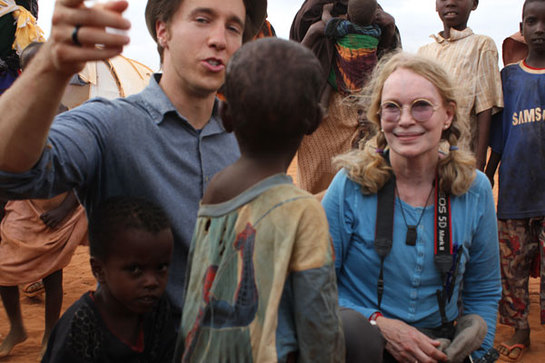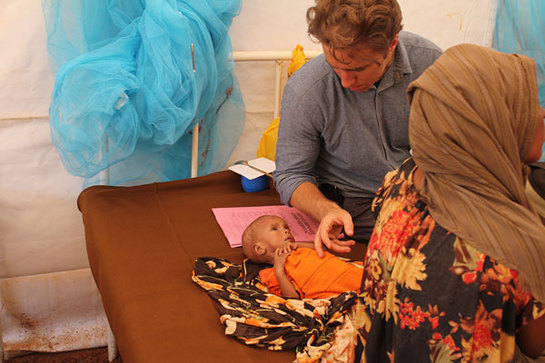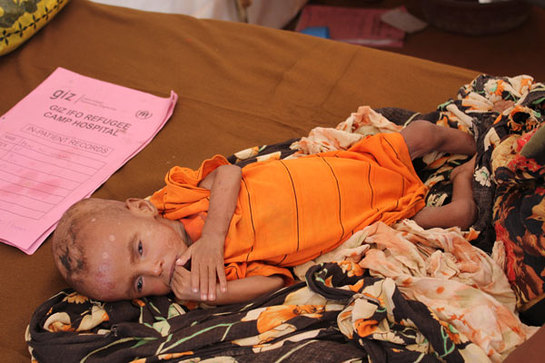Acclaimed actress, humanitarian and UNICEF Ambassador Mia Farrow – along with child rights activist, humanitarian and Free The Children co-founder Craig Kielburger – have just returned from visiting the Dadaab Refugee Camp in Kenya, providing support and aid to the families affected by the East Africa drought. The two activists share some of their personal stories while visiting the refugee camp through the below joint article and photos.

Credit/Copyright: Justin Mwendwa, Free The Children
Dadaab: What Will Happen Now?
By Mia Farrow and Craig Kielburger, Dadaab, Kenya
CNN’s Anderson Cooper and the other A-list TV journalists are long gone from Dadaab refugee camp on the Somali border. The huge satellite dish, which enabled live broadcasts, was packed up last week and trucked away.

Credit/Copyright: Justin Mwendwa, Free The Children
Relief workers told us their hearts sank as the dish departed. Much more than a journalistic tool, it had been a beacon of hope. As long as the stories of drought and death were being transmitted, help would surely come: donations, food, and the world’s compassion.
But what will happen now? This is still the most desperate place on Earth, and the situation is deteriorating, even if there is no one here to broadcast the stories of the suffering, stories like that of Ibrahim Ali.

Credit/Copyright: Justin Mwendwa, Free The Children
Ali, a farmer from southern Somalia, told us that because of the drought his crop had failed for the past four seasons, and his livestock died. Without food or savings, he and his wife and four children grew weaker. They could not survive for long. Ali heard there was a ‘safe place’ at the Kenyan border. The family left their home and everything they knew in a desperate search for food and water. They walked for 21 days.

Credit/Copyright: Craig Kielburger, Free The Children
On this day we meet Ali sitting in a long line of refugees waiting for a medical exam at the gateway to Dadaab, a sprawl of tents lashed to the desert floor. He clutches a gaunt six-year-old boy, who seemed to look through us with his glassy eyes.
“Where are your other children? Your wife?” we asked the father, quietly.
Ali looking down into the dust, whispers his reply. On the long walk to Dadaab, his wife, then three of the children fell ill, and one by one, they died. He buried each of them as best he could along the roadside. He told us he wanted to sit down and die, too, but there was one remaining son. Ali was determined to save him, and so they walked on.

Credit/Copyright: Craig Kielburger, Free The Children
Now this family of just two has joined more than 400,000 people at the camp, with at least 1,500 new refugees arriving from Somalia each day.
We met three-year-old Ali Noor Gedi in a make-shift ICU medical tent. Nurses measured the thickness of his match-stick thin arm. They will try to feed him, not by mouth or veins, but by threading a tube through his nose to pump a milky liquid into his stomach.
The child tries to cry, but his body is unable to make tears.
We don’t know if he will be able to absorb the nutrients, or if help for Ali Noor Gedi has come too late.
Kenyans, too, are facing starvation. In desperation, some have tried to pass themselves off as refugees in order gain access to the camp, and the dwindling food rations. But they are ousted, and left to fend for themselves.
There is no major media here to tell of the story of refugees like Ibrahim or Ali Noor Gedi, or of the hunger of the Kenyans, or of the millions of children across the Horn of Africa.

Credit/Copyright: Craig Kielburger, Free The Children
The World Food Programme, the sole supplier of food for refugees here, does not have the funding to cover this catastrophic humanitarian crisis. WFP has helped nearly eight million drought-stricken people in the Horn of Africa since last July, but it does not have the $250 million necessary to sustain people over the next six months.
Before leaving Dadaab, journalists on our nightly news predicted that the rains would come in October, implying that this would end the crisis. But that is not the whole truth. The planting season will have passed. The rains, if they come, will likely bring flooding and disease, including cholera.
It is believed that the famine will peak at the end of November or early December, as we are preparing to celebrate our winter holidays.
A generation ago, in 1991 and 1992, the world responded to save millions of Ethiopians from famine. Please don’t look away from Ibrahim Ali and his six-year-old son. Spare a thought for Ali Noor Gediin the ICU, and for the 12.5 million souls in East Africa who are facing starvation today and for the next several months.
Without further delay governments must make good on their pledges to the World Food Program. And each of us should do what we can before millions of the world’s most vulnerable people perish.
One dollar can sustain one person for one day. Imagine if everyone gave at this time, and through the holiday season. Long after the satellite dish has gone.
Photos: Justin Mwendwa and Craig Kielburger via Free The Children





